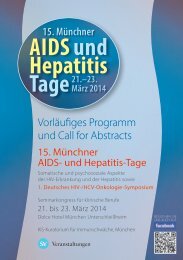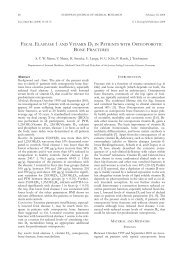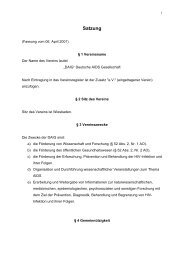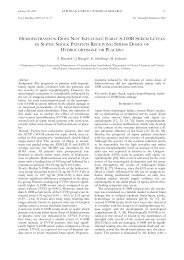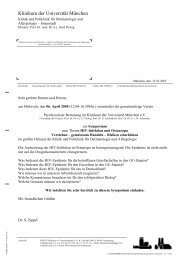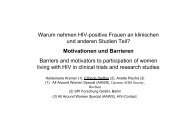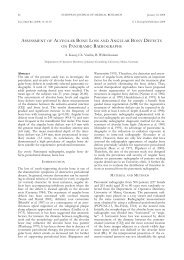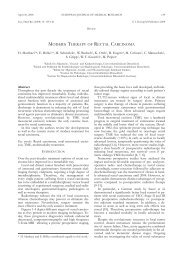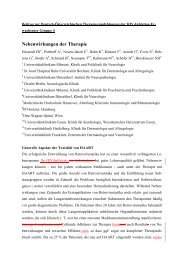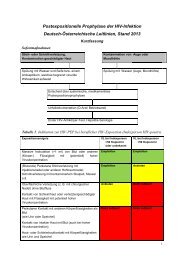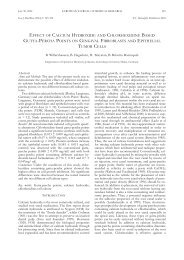European Journal of Medical Research - Deutsche AIDS ...
European Journal of Medical Research - Deutsche AIDS ...
European Journal of Medical Research - Deutsche AIDS ...
Create successful ePaper yourself
Turn your PDF publications into a flip-book with our unique Google optimized e-Paper software.
114 EUROPEAN JOURNAL OF MEDICAL RESEARCH<br />
June 27, 2007<br />
E. Virologie<br />
E.1 (Vortrag)<br />
More than one interaction: GBV-C clinical isolates<br />
differ in the ability to interfere with entry and post<br />
entry replication steps <strong>of</strong> HIV<br />
Jung S. 1 , Tenckh<strong>of</strong>f S. 2 , Tillmann H. 2 , Müller R. 1 ,<br />
Hess G. 3 , Fleckenstein B. 1 , Reil H. 1<br />
1 Universitätsklinikum Erlangen, Virologisches Institut,<br />
Erlangen, Germany, 2 Universität Leipzig, Innere Medizin,<br />
Gastroenterologie, Leipzig, Germany, 3 Roche, Diagnostics,<br />
Mannheim, Germany<br />
Objective: The majority <strong>of</strong> clinical studies suggest a beneficial<br />
effect <strong>of</strong> GBV-C long-term viremia for HIV patients. In<br />
vitro studies reveal a direct influence <strong>of</strong> GBV-C on HIV replication.<br />
Recently we demonstrated that the GBV-C mediated<br />
HIV-inhibitory effect is not restricted to X4- or R5-tropic<br />
HIV isolates nor to different HIV clades. Now, we studied the<br />
HIV inhibitory capacity <strong>of</strong> different GBV-C isolates and the<br />
mechanism in more detail.<br />
Methods: GBV-C viremia and replication capacity <strong>of</strong> respective<br />
isolates were monitored by real-time RT-PCR. GBV-C<br />
phenotypes were determined in co-infection experiments. E2<br />
protein fused to the human IgG-Fc was expressed, purified<br />
and used to stimulate cells before HIV infection. A singleround-<strong>of</strong>-replication<br />
HIV assay was performed to differentiate<br />
between GBV-C mediated inhibition <strong>of</strong> early and later HIVreplication<br />
steps.<br />
Results: GBV-C isolates differ in the ability to suppress HIV<br />
replication and thus can be classified as HIV inhibitors and<br />
non-inhibitors. The different GBV-C phenotypes could be<br />
confirmed independently in a second laboratory, but do not<br />
correlate with their replication ability in vitro. The majority <strong>of</strong><br />
GBV-C isolates leads to suppression <strong>of</strong> HIV replication independent<br />
<strong>of</strong> entry. But in contrast, some GBV-C isolates interfere<br />
only with HIV entry and not with later steps. We could<br />
identify the GBV-C E2 protein to be responsible for HIV entry<br />
inhibition, but definitely not for post entry events. Therefore<br />
other probably nonstructural GBV-C proteins interfere<br />
with later HIV replication steps.<br />
Conclusions: Our results reveal that GBV-C mediated HIV<br />
impairment depends on different GBV-C proteins which interfere<br />
with several HIV replication steps. The GBV-C E2<br />
protein interferes exclusively with X4- and R5-HIV entry,<br />
whereas additionally other GBV-C components suppress post<br />
entry events. These findings could be supported by the fact<br />
that several GBV-C isolates differ in the degree <strong>of</strong> occurrences<br />
<strong>of</strong> these HIV-inhibitory attributes. The existence <strong>of</strong><br />
different HIV inhibitory phenotypes may explain the controversial<br />
epidemiological data on the influence <strong>of</strong> GBV-C for<br />
HIV progression in vivo. In addition, the identification <strong>of</strong> the<br />
E2 protein as a HIV entry-inhibitor may lead to new HIV<br />
therapeutics.<br />
E.2 (Vortrag)<br />
HIV cleavage site mutations in patients with<br />
failing protease-inhibitor therapies<br />
Verheyen J. 1 , Litau E. 1 , Schuldenzucker U. 2 , Oette M. 3 ,<br />
Fätkenheuer G. 4 , Rockstroh J. 5 , Stellbrink H.-J. 6 ,<br />
Däumer M. 1 , H<strong>of</strong>fmann D. 7 , Pfister H. 1 , Kaiser R. 1<br />
1 University <strong>of</strong> Cologne, Institute <strong>of</strong> Virology, Köln, Germany,<br />
2 caesar, Bonn, Germany, 3 University Clinic Düsseldorf, Clinic<br />
for Gastroenterology, Hepatology and infectious Diseases,<br />
Düsseldorf, Germany, 4 University <strong>of</strong> Cologne, Department <strong>of</strong><br />
Internal Medicine 1, Köln, Germany, 5 University <strong>of</strong> Bonn,<br />
Department <strong>of</strong> Internal Medicine 1, Bonn, Germany,<br />
6 Grindelpraxis, Hamburg, Germany, 7 University <strong>of</strong> Duisburg-<br />
Essen, Center for <strong>Medical</strong> Biotechnology, Essen, Germany<br />
HIV cleavage site (CS) mutations increasingly attract attention<br />
in the analysis Protease-Inhibitor (PI) resistance. More<br />
efficient cleavage <strong>of</strong> gag precursor proteins enhance replication<br />
under selective pressure <strong>of</strong> PIs and confer PI resistance.<br />
Although CS mutations could be correlated with different protease<br />
resistance pr<strong>of</strong>iles, knowledge about the occurrence <strong>of</strong><br />
CS mutations under selective pressure <strong>of</strong> certain PIs remained<br />
rudimentary.<br />
We analysed HIV <strong>of</strong> patients (n=195) under failing PI therapies<br />
(APV n=34, IDV n=17, LPV n=71, SQV n=28 or double<br />
PIs n = 22) with detectable viral loads in the pol gene as<br />
well as in the C-terminal gag region. PR/RT genotypes were<br />
interpreted with geno2pheno (www.genafor.org) and CS mutations<br />
were scored in comparison to HxB2. Statistical significance<br />
was determined using Fisher´s exact test (p



